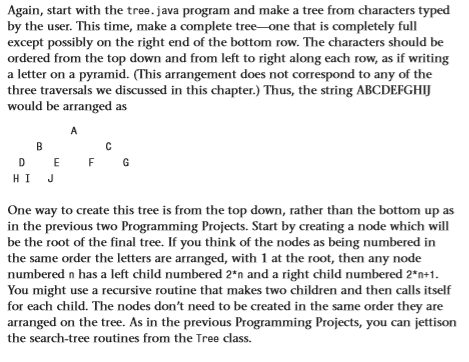Question
Help needed with a Java program! Please and thanks. A string must be used as the input from the user. Below is tree.java -------------------------- class
Help needed with a Java program! Please and thanks.

A string must be used as the input from the user.
Below is tree.java
--------------------------
class Node { public int iData; public double dData; public Node leftChild; public Node rightChild;
public void displayNode() { System.out.print('{'); System.out.print(iData); System.out.print(", "); System.out.print(dData); System.out.print("} "); } }
class Tree { private Node root;
public Tree() { root = null; }
public Node find(int key) { Node current = root; while(current.iData != key) { if(key
public void insert(int id, double dd) { Node newNode = new Node(); newNode.iData = id; newNode.dData = dd; if(root==null) root = newNode; else { Node current = root; Node parent; while(true) { parent = current; if(id
public boolean delete(int key) { Node current = root; Node parent = root; boolean isLeftChild = true;
while(current.iData != key) { parent = current; if(key
else if(current.rightChild==null) if(current == root) root = current.leftChild; else if(isLeftChild) parent.leftChild = current.leftChild; else parent.rightChild = current.leftChild;
else if(current.leftChild==null) if(current == root) root = current.rightChild; else if(isLeftChild) parent.leftChild = current.rightChild; else parent.rightChild = current.rightChild;
else { Node successor = getSuccessor(current);
if(current == root) root = successor; else if(isLeftChild) parent.leftChild = successor; else parent.rightChild = successor;
successor.leftChild = current.leftChild; }
return true; }
private Node getSuccessor(Node delNode) { Node successorParent = delNode; Node successor = delNode; Node current = delNode.rightChild; while(current != null) { successorParent = successor; successor = current; current = current.leftChild; }
if(successor != delNode.rightChild) { successorParent.leftChild = successor.rightChild; successor.rightChild = delNode.rightChild; } return successor; }
public void traverse(int traverseType) { switch(traverseType) { case 1: System.out.print(" Preorder traversal: "); preOrder(root); break; case 2: System.out.print(" Inorder traversal: "); inOrder(root); break; case 3: System.out.print(" Postorder traversal: "); postOrder(root); break; } System.out.println(); }
private void preOrder(Node localRoot) { if(localRoot != null) { System.out.print(localRoot.iData + " "); preOrder(localRoot.leftChild); preOrder(localRoot.rightChild); } }
private void inOrder(Node localRoot) { if(localRoot != null) { inOrder(localRoot.leftChild); System.out.print(localRoot.iData + " "); inOrder(localRoot.rightChild); } }
private void postOrder(Node localRoot) { if(localRoot != null) { postOrder(localRoot.leftChild); postOrder(localRoot.rightChild); System.out.print(localRoot.iData + " "); } }
public void displayTree() { Stack globalStack = new Stack(); globalStack.push(root); int nBlanks = 32; boolean isRowEmpty = false; System.out.println( "......................................................"); while(isRowEmpty==false) { Stack localStack = new Stack(); isRowEmpty = true;
for(int j=0; j while(globalStack.isEmpty()==false) { Node temp = (Node)globalStack.pop(); if(temp != null) { System.out.print(temp.iData); localStack.push(temp.leftChild); localStack.push(temp.rightChild); if(temp.leftChild != null || temp.rightChild != null) isRowEmpty = false; } else { System.out.print("--"); localStack.push(null); localStack.push(null); } for(int j=0; j class TreeApp { public static void main(String[] args) throws IOException { int value; Tree theTree = new Tree(); theTree.insert(50, 1.5); theTree.insert(25, 1.2); theTree.insert(75, 1.7); theTree.insert(12, 1.5); theTree.insert(37, 1.2); theTree.insert(43, 1.7); theTree.insert(30, 1.5); theTree.insert(33, 1.2); theTree.insert(87, 1.7); theTree.insert(93, 1.5); theTree.insert(97, 1.5); while(true) { System.out.print("Enter first letter of show, "); System.out.print("insert, find, delete, or traverse: "); int choice = getChar(); switch(choice) { case 's': theTree.displayTree(); break; case 'i': System.out.print("Enter value to insert: "); value = getInt(); theTree.insert(value, value + 0.9); break; case 'f': System.out.print("Enter value to find: "); value = getInt(); Node found = theTree.find(value); if(found != null) { System.out.print("Found: "); found.displayNode(); System.out.print(" "); } else System.out.print("Could not find "); System.out.print(value + ' '); break; case 'd': System.out.print("Enter value to delete: "); value = getInt(); boolean didDelete = theTree.delete(value); if(didDelete) System.out.print("Deleted " + value + ' '); else System.out.print("Could not delete "); System.out.print(value + ' '); break; case 't': System.out.print("Enter type 1, 2 or 3: "); value = getInt(); theTree.traverse(value); break; default: System.out.print("Invalid entry "); } } } public static String getString() throws IOException { InputStreamReader isr = new InputStreamReader(System.in); BufferedReader br = new BufferedReader(isr); String s = br.readLine(); return s; } public static char getChar() throws IOException { String s = getString(); return s.charAt(0); } public static int getInt() throws IOException { String s = getString(); return Integer.parseInt(s); } }
Step by Step Solution
There are 3 Steps involved in it
Step: 1

Get Instant Access to Expert-Tailored Solutions
See step-by-step solutions with expert insights and AI powered tools for academic success
Step: 2

Step: 3

Ace Your Homework with AI
Get the answers you need in no time with our AI-driven, step-by-step assistance
Get Started


